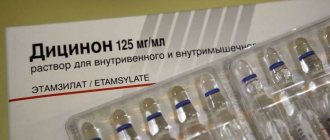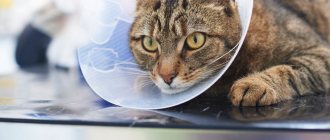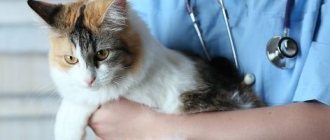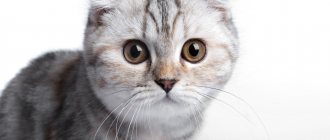Causes of cryptorchidism in cats Diagnostics Treatment Caring for a cat after castration Cryptorchidism in cats is a congenital developmental pathology in which one or both testicles (testes) do not descend into the scrotum, but remain and develop in the abdominal cavity or in the inguinal canals. Typically, an owner notices cryptorchidism in their pet at the age of 2-4 months. However, some owners are unaware of the existence of this problem for quite a long time.
It is believed that cryptorchidism is inherited, so cryptorchid animals are recommended to be castrated and removed from breeding.
In cats, unilateral cryptorchidism most often occurs - that is, when only one testis does not descend into the scrotum, the second one develops normally. Such cats are capable of reproduction. Less common is bilateral cryptorchidism, the undescended state of both testes; with this pathology, the cat most often remains sterile, that is, incapable of reproduction - this is due to the fact that the temperature in the abdominal cavity is higher than necessary to maintain the viability of the seed.
Depending on the type of development, cryptorchidism can be inguinal or abdominal (sometimes also called abdominal). With inguinal cryptorchidism, the testicles are located in the inguinal canal, with abdominal cryptorchidism - in the abdominal cavity.
What is cryptorchidism
At the time of birth in males, the testicles are located in the abdominal cavity. As the animal develops sexually, the testes descend into the scrotum. If this does not happen, then veterinarians call this defect cryptorchidism.
In cryptorchids, the testicle is located either under the skin in the groin or in the abdominal cavity. This defect is inherited, so cryptorchids are excluded from breeding.
Veterinarians divide two types of cryptorchidism:
- Unilateral. One of the testicles is missing from the scrotum. Most often, undescended left testicular gland is observed.
- Bilateral. Both sex glands are located in the groin or abdominal cavity.
In most cases, the pathology is congenital. It is considered a consequence of improper formation of the genital organs during the prenatal period. Cubs are already born with a short spermatic cord or an excessively narrowed inguinal canal. All this prevents the prolapse of the testes.
Very rarely, cryptorchidism is acquired. The cause of this anomaly is injuries to the abdomen and scrotum. Therefore, small cubs must be protected from falls and blows.
Causes of the disease
There are a number of factors in the formation of cryptorchidism:
- Hormonal conditions. Pathology of the reaction of testosterone with hormones formed by the pituitary gland. During normal production of these substances by the cat’s body, the testes descend into the scrotum. When hormone production is disrupted, the system that causes the testes to descend stops functioning. Depending on the moment when this happened, different types of cryptorchidism occur.
- Innervation disorder. When nerve conduction is disrupted, degenerative processes begin in the muscular system, since normal physiological metabolism in muscle fibers is directly related to innervation. Because of this, the ligamentous apparatus contracts, as a result of which the testes do not exit into the scrotum.
How to identify an anomaly
Cryptorchidism can also be detected at home. To do this, you need to palpate the animal's scrotum. Normally, palpation reveals two formations similar in shape to beans. If only one testis is palpable, then in most cases this is a sign of cryptorchidism.
However, diagnosing your pet yourself can sometimes be difficult. There are also cases of false cryptorchidism. The testicular gland may become dislodged due to sudden muscle contraction. This phenomenon occurs during cold weather or when the animal is frightened. Therefore, it is better to seek help from a veterinarian. The specialist makes a diagnosis of cryptorchidism after repeated palpation of the animal.
Is it dangerous
Is cryptorchidism dangerous? Usually, owners do not notice any deviations in the behavior and condition of the animal. The absence of one or two gonads in the scrotum does not in any way affect the well-being of the pet. For this reason, contacting a veterinarian is often postponed.
However, cryptorchidism can have quite serious consequences. It is in the scrotum that the most favorable conditions are created for the normal functioning of the testicles. If the seminal glands are located in the groin or abdominal cavity, then they are constantly exposed to overheating. Over time, this can provoke malignant tumors of the testes. It is for this reason that veterinarians recommend castration of cryptorchid.
Testicular tumors are most often seen in dogs with cryptorchidism. However, such a complication cannot be ruled out in cats and stallions. In any case, the presence of the testes in the groin or abdomen has a detrimental effect on the condition of the tissues of the gonads.
In addition, cryptorchidism can cause testicular torsion and prostate tumors. We can conclude that such an anomaly is far from harmless.
A few words about castration of cats
Castration of males is an operation to completely remove the gonads (testes). The most common type of pet that is castrated is cats.
It makes sense to clarify a few points regarding castration of cats (currently in Saratov and in general).
I. Cryptorchid/non-cryptorchid. II. Surgical access. III. Choice of anesthesia. IV. The presence or absence of a seam. V. Duration of postoperative care.
I. Speaking about surgery in the area of the testes, let us explain the meaning of the terms “cryptorchidism” and “cat-cryptorchid” . During the formation of a male kitten in the womb, the testes are located in the abdominal cavity. At the time of birth or in the first 30 to 45 days after birth, they should be in the scrotal cavity. After the “descent of the testes” into the scrotum (medical term), you can safely carry out castration according to the classic version. In some cases (most often due to genetic predisposition), one testis does not descend into the scrotal cavity (less often, two). In this case, they speak of unilateral (or bilateral) cryptorchidism. Cryptorchidism (“cryptos” - “hidden”, “orchis” - “testis”) is a disease in which the male does not descend one or both testes into the scrotum. For this reason, castration of a cat and castration of a cryptorchid cat are two completely different operations. Castration of cryptorchid can be performed in several ways, depending on the location of the testis. The question of the peculiarities of castration of cryptorchids will be considered separately in the future. The article discusses the option of “regular” castration, when the cat is not cryptorchid.
Preparing the Operation Field
II. Surgical access: open castration wound. The surgical technique consists of cutting the skin of the scrotum, extracting and removing (after pulling large blood vessels) the testis itself and its appendage. Thus, after castration, “the cat has nothing left.” The gonads (sources of sex hormones and genetic material) are completely removed. Sutures are not applied to the skin of the scrotum during castration of cats. After the operation, an open wound is left, which heals on its own in 3 to 7 days. This technique is due to the close location of the penis and scrotum in cats, which does not make it possible to perform the operation “like a dog” (without affecting the tissue of the scrotum and with sutures). In this way, only cats are usually castrated among non-productive and ornamental animals (males of other animal species - only according to indications). Pros. 1. Speed of implementation and possibility of local anesthesia. This allows the use of short-acting hypnotics (propofol) or muscle relaxants, which only immobilize, but do not provide deep analgesia (xylazine). 2. No seams. There can be no complications with this. They do not need to be removed or protected. Minuses. 1. After surgery, an open wound remains, which can become infected in various ways. 2. There is a risk of developing extensive postoperative bleeding. 3. There is always a slight gaping of the castration wound and capillary bleeding, which leads to a temporary loss of the aesthetic qualities of the animal.
III. As for anesthesia. It is always necessary and necessary to discuss the issue of anesthetic risk, i.e. the risk of death of the animal after the administration of drugs for sedation (in the state “under anesthesia” and during the period of “recovery from anesthesia”). For young, clinically healthy cats, this risk is minimal (less than 1% of cases). Certain breeds of cats (British Folds, Scottish Folds, Maine Coons, and other large breeds) are slightly more likely to die due to the possibility of an underlying breed-related heart muscle defect (HCM). When using different anesthetic agents and their combinations, the anesthetic risk is different. But he is always there. This should be understood. The ideal safe anesthesia has not yet been created. According to the method of administration, drugs for sedation are divided into the following: - for intravenous administration (propofol); - by intramuscular or subcutaneous injection (xylazine, medetomidine, xylazine + zoletil). Of these, intramuscular injection of xylazine is actually used for castration of cats. Relatively recently, a more progressive method of intravenous administration of the drug propofol has come into practice. The promising (especially for aggressive cats) medetomidine + zoletil regimen is not yet widely used. What are the differences between these drugs? Neither xylazine nor propofol provide, as such, pronounced anesthesia sufficient to perform castration alone. The purpose of their use is to calm and immobilize the animal, which makes it possible to technically carry out the operation. Pain relief is achieved primarily through local anesthesia (lidocaine). Differences.
Xylazine
Xylazine (rometar, xyla). Pros. 1. Simplicity, speed and “stress-free” administration (intramuscular or subcutaneous injection). 2. Lower cost of surgery. Minuses. 1. Significantly reduces blood pressure and depresses breathing for a long time. 2. Duration of achieving relaxation (5 – 30 minutes after drug administration). 3. It is not always possible to achieve complete immobilization and relaxation. 4. Recovery lasts from 3 to 24 hours (and sometimes longer). 5. The period of action of the drug is most often accompanied by single or multiple vomiting (a starvation diet is required before and after surgery). 6. Negative effect on the myocardium due to relaxation of all striated muscles. 7. Risk of developing intestinal atony due to a smaller, but still effect on smooth muscle. 8. Antidotes to xylazine are not usually used.
Veterinary version of propofol
Propofol (diprivan, anestofol). Pros. 1. When the drug is administered instantly (“on the needle”), complete relaxation of the animal is achieved. 2. The effect (complete relaxation) clearly lasts 20 – 40 minutes, which is more than enough for the operation. 3. Full recovery of the animal most often occurs within 1 – 2 hours (appetite, precise coordination of movements). 4. Usually does not cause vomiting (does not require a strict starvation diet). 5. It is considered the safest means of short-term sedation currently available in veterinary medicine. Minuses. 1. Strictly intravenous administration is necessary. 2. Higher cost of the operation (due to the cost of the drug and the complexity of administration). 3. Possible short-term depression of the respiratory center during the operation. 4. Cosmetic defect (shaved hair on a limb) at the site of intravenous administration of the drug.
IV. As for the seams, everything is simple here. Sutures are not used during castration of cats.
V. Postoperative monitoring of the animal's condition is usually not very complicated and depends on the sedation agent used. The owner is required to supervise his pet. If any disturbing changes in condition occur, you should consult by phone or contact a veterinary clinic for a re-examination. When using xylazine. 1. During the period of “coming out of anesthesia” (12 – 48 hours) until coordination is restored, it is desirable to limit the patient in space (carrying, small room). 2. Avoid any drafts and low air temperature in the room. 3. A starvation diet is maintained (often the animal itself refuses food). 4. Control of vomiting. 5. Monitoring the condition of the surgical wound (inspecting the surgical area 1 – 2 times a day). When using propofol . 1. During the period of “coming out of anesthesia” (1 – 3 hours) until coordination is restored, it is desirable to limit the patient in space (carrying, small room). 2. Monitoring the condition of the surgical wound. Thus, after the decision has been made to castrate the cat, the owner can only: 1) decide whether the cat is cryptorchid or not (on his own or in a veterinary clinic); 2) realize the presence of anesthetic risk; 3) choose a “drug for anesthesia” (after consultation with a veterinary specialist); 4) be mentally prepared to observe and care for the animal in the postoperative period.
Remark.
In this article, to facilitate the perception of information, not entirely correct terms are used: “coming out of anesthesia”, “under anesthesia”. This is done only for the purpose of simplifying the already quite voluminous material.
Veterinarian Artem Arkadievich Kazakov
Need for surgery
Cryptorchid castration is a more complex surgical procedure than conventional sterilization of a healthy animal. Many owners are afraid to subject their pet to such a procedure.
However, veterinarians strongly recommend castration for cryptorchidism. After all, this anomaly cannot be cured by other methods. The operation is necessary for the following reasons:
- castration prevents the risk of tumors;
- transmission of the defect to offspring is excluded;
- problems associated with sexual behavior (the need to mark territory, aggressiveness) are eliminated.
Often, owners ask the veterinarian not to castrate the animal, but to perform an operation to lower the gonads into the scrotum. However, such surgical intervention is performed extremely rarely. After all, after this operation there is a danger of transmitting the anomaly to subsequent generations and all problems associated with sexual behavior remain. Therefore, in the vast majority of cases with congenital cryptorchidism, experts recommend castration.
Very rarely, in cases of acquired cryptorchidism in cats, surgical intervention is replaced with hormonal therapy. However, in this case, the animal has to inject huge doses of testosterone, which has a negative effect on the body. Such treatment is carried out only if there are serious contraindications to surgery.
Preparing for surgery
Before castration of a cryptorchid, the animal is carefully prepared for surgery. The preoperative period consists of the following stages:
- The veterinarian palpates the scrotum and abdomen.
- An ultrasound examination is prescribed. This helps determine the location of the gonads.
- The animal is given a blood test, urine test and an electrocardiogram. The examination allows you to determine your general health.
- If the pet has not been vaccinated previously, then 2 - 3 weeks before castration you need to give it all the necessary vaccinations.
- Approximately 3 weeks before the scheduled operation, anthelmintic treatment should be carried out.
- The day before castration, the animal must be thoroughly washed with antiparasitic shampoo.
- 8 hours before surgery you should avoid eating.
Operation technique
What surgical technique is used for castration of cryptorchid? It all depends on the type of anomaly. If the gonads are located under the skin in the groin area, then this is the mildest case. With such localization of the testicles, the operation consists of the following steps:
- On the surgical field, the hair is shaved and the skin is treated with antiseptics.
- The animal is injected with a local anesthetic.
- An incision is made in the skin over the testis.
- The gonad is separated from the adipose tissue.
- A ligature is applied to the spermatic cord.
- The testicle is completely cut off.
It is very important to remove the second testicular gland from the scrotum. Otherwise, the animal will retain the ability to reproduce and the need to mark territory. The second testicle is cut off in the traditional way, as during normal castration.
If the gonads are located in the abdominal cavity, then a more complex operation must be performed. It is performed under general anesthesia. In this case, the skin is cut very deeply to penetrate the abdominal cavity. The testis is also separated from the fat and then removed. In terms of complexity, this surgical intervention can be compared to sterilization of a female. This operation requires longer rehabilitation.
Consequences
If a testicle has been removed from the subcutaneous area, the pet can be taken home immediately from the clinic. If the animal has undergone abdominal surgery, then in some cases a hospital stay may be required.
During the postoperative period, you need to carefully monitor your pet's condition. The owner should be wary of the following manifestations:
- severe vomiting;
- hoarse and heavy breathing;
- blue skin;
- rare and weak pulse;
- lack of reaction to light, sounds and touches 6 - 8 hours after anesthesia.
In these cases, it is necessary to urgently contact a veterinarian.
Next, we will look at the rules for caring for different types of animals in the postoperative period.
How long does it take to recover from anesthesia?
This question worries everyone without exception. And this is understandable: it is important for owners to know that everything is fine with their pet.
Unfortunately, there is no exact answer to this. It all depends on the drug, dose, and temperament of the animal. A phlegmatic cat with a strong nervous system will require less anesthesia than another with the same body weight, but who is nervous and hyperactive. Some animals, an hour or two after the operation, move around the floor, strive to climb higher and demand food, while others sleep for almost a day and do not even look towards the plate.
How to care for a cat after surgery
After castration of a cryptorchid cat, the postoperative period is more difficult than after conventional sterilization. The animal needs serious care. First of all, it is necessary to protect the suture area from licking. To do this, put a special blanket on the cat. It must be worn for at least 10 days. This method of wound protection is indicated after abdominal surgery.
If, during castration, a cryptorchid cat’s testicle was removed from under the skin, then you need to put a special protective collar on the pet. The blanket does not protect the groin area well. The collar should also be worn for about 10 days.
A cryptorchid cat usually asks for food after castration. After all, the animal had to go without food for a long time. However, under no circumstances should you overfeed your pet. You need to give food in small portions. In the future, the animal’s diet should consist of special feed for castrates. It is important to remember that sterilized cats are very prone to obesity and urolithiasis.
How can you determine if everything is going well?
Within 24 hours after surgery, has your pet had a “small nap” at least once and is keenly interested in what it smells so good about? There is nothing to worry about, he is fine. The cat does not come to his senses, does not try to get up and has never relieved himself at least on the bedding? It's time to sound the alarm. Urgently take him to the clinic where he was operated on, or to any other. Everything can be fixed, just don’t hesitate.
Until the anesthesia wears off, the cat lies without making any movements, often with his eyes open, without blinking. This can cause the cornea to dry out. From time to time you need to very carefully touch the animal's eyelid with your finger. When you do this, the cat blinks, and the mucous membrane of the eyes is moistened by tear fluid. Just be extremely careful not to get your nail in the eye! After the operation, the cat should be on the floor. There is no need to put it on a bed or in a chair. After recovering from anesthesia, the animals begin to crawl, but their coordination of movements during this period is very poor. If a cat falls in this state, even from a small height, it can seriously hurt itself.
Anesthesia causes a decrease in body temperature. The cat will be cold on the bare floor. Try to create comfortable conditions for him:
- close windows and doors to prevent drafts;
- lay a warm bedding on the floor;
- cover the cat with a woolen blanket;
- Check the room temperature and, if necessary, increase it using a heater.
Under no circumstances should you pour water into your cat's mouth! Neither a syringe nor a douche! When an animal is under anesthesia, water poured into the mouth can cause vomiting and enter the respiratory tract. The cat will choke and die. If you are unable to wait quietly until your pet wakes up completely, periodically wet his lips with a few drops (no more!) of fresh warm water.
All owners of neutered cats are concerned with the question: what should be the care for the postoperative suture? Much to the relief of loving owners, practically nothing is required from them in this regard. A sutured wound does not require treatment. Castration is a much less complicated operation than sterilizing a cat. Having woken up from anesthesia, the cat feels cheerful and healthy. The stitch does not give him any trouble. Only occasionally, in isolated cases, cats lick the wound too diligently, not allowing it to heal normally. In this case, the animals are put on a funnel-shaped collar, in which they cannot lick themselves, or a diaper. Some witty owners dress up their pets in self-sewn “family” panties of the appropriate size. The main thing is to prevent the wound from licking.
There is no need to interfere with the cat's desire to warm up a little. If he is able to move, let him crawl a little. You don’t have to worry about the condition of the seams - they won’t come apart. However, it is still not worth leaving the cat unattended: he may try to climb onto his favorite chair, and since his coordination is still poor, he will probably fall.
Caring for your dog after surgery
Castration of a male cryptorchid is a necessary measure. If the testicles are not properly localized, malignant tumors often occur in dogs. Cryptorchidism in males is also accompanied by severe hormonal imbalance. This is fraught not only with the appearance of dangerous tumors, but also with diabetes.
With cryptorchidism in dogs, the testicles are most often located in the abdominal cavity. Veterinary surgeons have to use the cavity method of castration of cryptorchid males. The peculiarity of the operation is that after the intervention a deep wound remains on the abdomen. Therefore, it is very important to prevent licking of the seam. To do this, put a collar or blanket on the dog. It is also necessary to periodically treat the seam with an antiseptic.
After castration, cryptorchid dogs have an increased risk of thyroid disease. After all, such an operation changes the hormonal background of the body. Therefore, the animal must undergo regular veterinary examinations.
Complications from pathology
Cryptorchidism is dangerous, so it needs to be treated in a timely manner; the consequences of this pathology are:
- Cancer. The probability of its occurrence increases 10 times. This happens due to increased temperature in the abdominal space and the impossibility of spermatogenesis, as a result of which first physiological and then genetic changes in tissue occur. The highest probability of developing a tumor is with a unilateral intra-abdominal location of the testicle.
- Testicular torsion. Because of this, a sharp, severe pain occurs, which often does not stop and causes severe suffering to the animal for a long time. In this situation, internal bleeding may also occur if the spermatic artery is damaged.
- Infertility is observed in 80% of cases with bilateral cryptorchidism, but is not recorded with unilateral cryptorchidism.
- Hernias. They often occur from birth. In this case, hernias can, under certain conditions, threaten the life of the animal.
- Prostate dysfunction and its cancerous degeneration.
- With the hormonal nature of cryptorchidism, when the testes do not respond to gonadotropic hormone, a lack of testosterone occurs. A low amount of it leads to increased work of the anterior pituitary gland, which entails a systemic disruption of hormonal metabolism.
Postoperative period in horses
Castration of a cryptorchid stallion is a rather complex operation. It leaves a large wound. The recovery period takes about 2 weeks. During this period it is necessary to keep the animal on a short leash. After surgery, antibiotics and anti-inflammatory drugs are indicated.
You need to carefully monitor the cleanliness of the room and the bedding. This will help prevent the wound from becoming infected. It is necessary to protect the animal from blood-sucking insects, as they can spread infections.
For 14 days after castration, the stallion is contraindicated in any physical activity. The food should be light, since disturbances in the gastrointestinal tract negatively affect wound healing.











